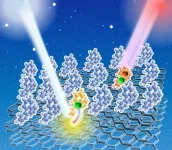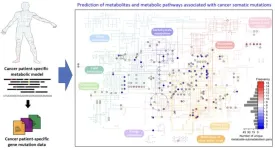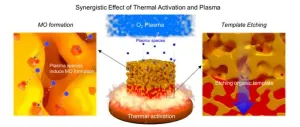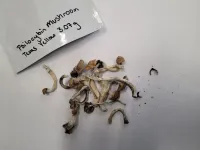Molecular orientation is key: shining new light on electron behavior using 2-photon photoemission spectroscopy
Understanding electron behavior and surface structure of triphenylene thin film molecules deposited on graphite substrates under light irradiation
2024-03-19
(Press-News.org)
Osaka, Japan – Organic electronics is a field that has garnered significant interest in academic and industrial circles due to its potential applications in OLEDs and organic solar cells, offering advantages such as lightweight design, flexibility, and cost-efficiency. These devices are made by depositing a thin film of organic molecules onto a substrate that acts as an electrode, and function by controlling the transfer of electrons between the thin film and the substrate. Therefore, understanding electron behavior at the interface between the substrate and the thin film, coupled with the electronic properties of the organic thin film, is crucial for the further advancement of organic electronics. Moreover, the simultaneous observation of photocarrier electrons and intramolecular photoexcitation would offer more insights into thin films of organic molecules.
Although the static electronic states of thin films of organic molecules have been studied in detail using a technique called photoelectron spectroscopy, the accurate detection of the dynamic behavior of electrons attempting to express their functions in devices has been challenging, hindering progress.
A research group led by Associate Professor Masahiro Shibuta of the Graduate School of Engineering at Osaka Metropolitan University observed the electronic behavior and surface structure of a thin film of triphenylene (TP) molecules deposited on a graphite substrate using two-photon photoemission (2PPE) spectroscopy, scanning tunneling microscopy and low-energy electron diffraction. The results showed that the TP molecules exhibit a special structure in which they are adsorbed in a standing-up configuration onto the substrate. Both electrons were injected from the substrate into the TP molecules upon light irradiation, and the electrons photo-excited in the molecular thin film were successfully observed simultaneously in a single sample. Additionally, strong photoluminescence was also observed on a thin film with only one layer of molecules in a special structure where the molecules were adsorbed diagonally on the substrate, as in the case of the TP molecules. It is expected that these results will contribute to the development of new luminescent materials and to the further development of functional organic electronic devices.
“2PPE spectroscopy is still a novel method for evaluating electronic states, but it suffers from the fact that the electronic states are sometimes well observed and sometimes not, despite the time-consuming nature of the well-optimized measurement,” Professor Shibuta said. “Our findings highlighted that the visibility of the electronic state is closely related to the adsorption mode of the molecule on the substrate and its electronic properties. In other words: Not only the type of molecules but also the way they are arranged must be properly controlled to create a device that can fully showcase their functions. I am delighted that our research is providing insights into the development of functional material for practical applications.”
The results were published in The Journal of Physical Chemistry C.
###
About OMU
Osaka Metropolitan University is the third largest public university in Japan, formed by the merger of Osaka City University and Osaka Prefecture University in 2022. OMU upholds the “Convergence of Knowledge” through 11 undergraduate schools, a college, and 15 graduate schools. For more research news, visit https://www.omu.ac.jp/en/ and follow us on X @OsakaMetUniv_en, Instagram, or Facebook.
END
ELSE PRESS RELEASES FROM THIS DATE:
2024-03-19
For decades, people with diabetes have relied on finger pricks to withdraw blood or adhesive microneedles to measure and manage their glucose levels. In addition to being painful, these methods can cause itching, inflammation and infection.
Researchers at TMOS, the Australian Research Council Centre of Excellence for Transformative Meta-Optical Systems, have taken an important step towards eliminating this discomfort. Their RMIT University team has discovered new aspects of glucose’s infrared signature and have used this information to develop a miniaturised optical sensor only 5mm in diameter that could one day be used to provide continuous non-invasive glucose monitoring in diabetes ...
2024-03-19
A new study in people undergoing surgery to treat seizures related to epilepsy shows that pauses in speech reveal information about how people’s brains plan and produce speech.
Led by researchers at NYU Grossman School of Medicine, the study results add to evidence that neighboring brain regions, the inferior frontal gyrus and the motor cortex, play an important role in such planning before words are said aloud. Both are part of the folded top layers of the brain, or cerebral cortex, which has long been known to control the muscle (motor) movements in the throat and mouth needed to produce speech. Less ...
2024-03-19
Cancer is characterized by abnormal metabolic processes different from those of normal cells. Therefore, cancer metabolism has been extensively studied to develop effective diagnosis and treatment strategies. Notable achievements of cancer metabolism studies include the discovery of oncometabolites* and the approval of anticancer drugs by the U.S. Food and Drug Administration (FDA) that target enzymes associated with oncometabolites. Approved anticancer drugs such as ‘Tibsovo (active ingredient: ivosidenib)’ and ‘Idhifa (active ingredient: enasidenib)’ ...
2024-03-19
Imaging being able to wear your smartphone on your wrist, not as a watch, but literally as a flexible band that surrounds around your arm. How about clothes that charge your gadgets just by wearing them? Recently, a collaborative team led by Professor Jin Kon Kim and Dr. Keon-Woo Kim of Pohang University of Science and Technology (POSTECH), Professor Taesung Kim and M.S./Ph.D. student Hyunho Seok of Sungkyunkwan University (SKKU), and Professor Hong Chul Moon of University of Seoul (UOS) has brought a step closer to making this realty. This research work was published in Advanced Materials.
Mesoporous ...
2024-03-19
A five-day course of once-daily inorganic nitrate reduces the risk of a serious complication following a coronary angiogram, in which the dye used causes damage to the kidneys. The clinical trial, led by Queen Mary University of London and funded by Heart Research UK, also showed that the five-day course improves renal outcomes at three months and major adverse cardiac events (MACE) at one year compared to placebo.
Contrast-induced nephropathy (CIN), also known as contrast associated acute kidney injury (CA-AKI), is an uncommon but serious complication following ...
2024-03-19
EMBARGOED FOR RELEASE
6 p.m. PT / 9 p.m. ET, March 18, 2024
To coincide with publication in The Gerontologist
Media Contact: Suzanne Leigh (415) 680-5133
Suzanne.Leigh@UCSF.edu
Subscribe to UCSF News
People with dementia and those who care for them should be screened for loneliness, so providers can find ways to keep them socially connected, according to experts at UC San Francisco and Harvard, who made the recommendations after finding that both groups experienced declines in social well-being as the disease progressed.
The patients, whose ...
2024-03-19
Since the 1970s, the federal government has listed the active ingredients in mushrooms—psilocybin and psilocin—as illegal and having no accepted medical use.
However, in recent years, medical professionals have found that these substances are safe and effective for treating stubborn conditions such as treatment-resistant depression and post-traumatic stress disorder. Some jurisdictions now allow for the medical use of mushrooms, while others are considering permitting or at least decriminalizing their recreational use.
Clinicians now find themselves needing to carefully ...
2024-03-19
Irvine, Calif., March 18, 2024 — A research team led by the University of California, Irvine has discovered the key role that the APOBEC3A and APOBEC3B enzymes play in driving cancer mutations by modifying the DNA in tumor genomes, offering potential new targets for intervention strategies.
The study, published today online in the journal Nature Communications, describes how the researchers identified the process by which APOBEC3A and APOBEC3B detect specific DNA structures, resulting in mutations at distinct positions within the tumor genome.
“It’s critical to understand how cancer cells accumulate mutations leading to ...
2024-03-18
The blue whale genome was published in the journal Molecular Biology and Evolution, and the Etruscan shrew genome was published in the journal Scientific Data.
Research models using animal cell cultures can help navigate big biological questions, but these tools are only useful when following the right map.
“The genome is a blueprint of an organism,” says Yury Bukhman, first author of the published research and a computational biologist in the Ron Stewart Computational Group at the Morgridge Institute, an independent research organization that works in affiliation with the University of Wisconsin–Madison in emerging fields ...
2024-03-18
Water pollution from dyes used in textile, food, cosmetic and other manufacturing is a major ecological concern with industry and scientists seeking biocompatible and more sustainable alternatives to protect the environment.
A new study led by Flinders University has discovered a novel way to degrade and potentially remove toxic organic chemicals including azo dyes from wastewater, using a chemical photocatalysis process powered by ultraviolet light.
Professor Gunther Andersson, from the Flinders Institute for NanoScale Science and Technology, says the process involves creating metallic ‘clusters’ of just nine gold (Au) atoms chemically ‘anchored’ ...
LAST 30 PRESS RELEASES:
[Press-News.org] Molecular orientation is key: shining new light on electron behavior using 2-photon photoemission spectroscopy
Understanding electron behavior and surface structure of triphenylene thin film molecules deposited on graphite substrates under light irradiation








